
- Remove this product from my favorite's list.
- Add this product to my list of favorites.
Products
Viewed products
Newsletter
 |  |  |  |  |  |

Background
CD44 antigen is a cell-surface glycoprotein involved in cell–cell interactions, cell adhesion and migration. CD44 is expressed in a large number of mammalian cell types. CD44 is a receptor for hyaluronic acid and can also interact with other ligands, such as osteopontin, collagens, and matrix metalloproteinases (MMPs). CD44 function is controlled by its posttranslational modifications. One critical modification involves discrete sialofucosylations rendering the selectin-binding glycoform of CD44 called HCELL (for Hematopoietic Cell E-selectin/L-selectin Ligand). CD44 participates in a wide variety of cellular functions including lymphocyte activation, recirculation and homing, hematopoiesis, and tumor metastasis. Transcripts for this gene undergo complex alternative splicing that results in many functionally distinct isoforms.
Source
Recombinant Human CD44 Protein (rhCD44), His Tag (CD4-H5226) is expressed from human 293 cells (HEK293). It contains AA Gln 21 - Pro 220 (Accession # AAH04372).
Predicted N-terminus: Gln 21
Molecular Characterization
This protein carries a polyhistidine tag at the C-terminus.
The protein has a calculated MW of 23.3 kDa. The protein migrates as 32-55 kDa under reducing (R) condition (SDS-PAGE) due to glycosylation.
Endotoxin
Less than 1.0 EU per μg by the LAL method.
Purity
>90% purity as determined by SDS-PAGE.
Formulation
Lyophilized from 0.22 μm filtered solution in PBS, pH7.4. Normally trehalose is added as protectant before lyophilization.
Reconstitution
See Certificate of Analysis for details of reconstitution instruction and specific concentration.
Storage
For long term storage, the product should be stored at lyophilized state at -20°C or lower.
Please avoid repeated freeze-thaw cycles.
This product is stable after storage at:
-20°C to -70°C for 12 months in lyophilized state;
-70°C for 3 months under sterile conditions after reconstitution.
Bioactivity
Please refer to product data sheet.
(1) "Spheroids derived from the stromal vascular fraction of adipose tissue self-organize in complex adipose organoids and secrete leptin"
Robledo, González-Hodar, Tapia et al
Stem Cell Res Ther (2023) 14 (1), 70
(2) "Multi-omic and spatial dissection of immunotherapy response groups in non-small cell lung cancer"
Monkman, Kim, Mayer et al
Immunology (2023)
(3) "Adiponectin-mediated promotion of CD44 suppresses diabetic vascular inflammatory effects"
Duan, Zhang, Xing et al
iScience (2023) 26 (4), 106428
Showing 1-3 of 21663 papers.
Follow us